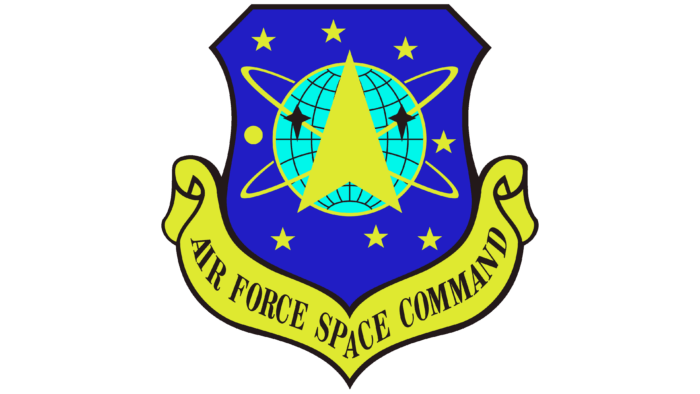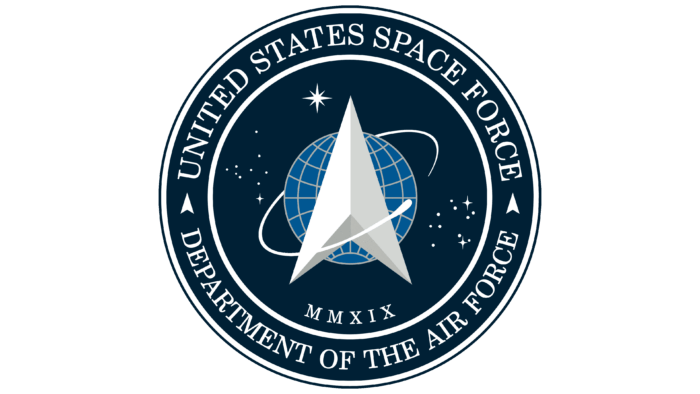 Us Air Force Space Command Logo PNG
Us Air Force Space Command Logo PNG
The Us Air Force Space Command logo flies across the starry sky above the Earth and protects the peace of its citizens, just like the organization that the emblem represents. Valor, protection, and innovation are encrypted in the signs, which guard peace and order.
Us Air Force Space Command: Brand overview
| Founded: | 23 September 1985 – 1 October 2002, 29 August 2019 – present |
| Headquarters: | Peterson Space Force Base, Colorado, U.S. |
| Website: | spacecom.mil |
Meaning and History
When Us Air Force Space Command ceased to exist, its logo became the basis for the U.S. Space Force emblem. In the original, it looked like a shaped shield of blue with lots of interesting details. In the center was a gray triangle in the form of an upward pointing arrow. It was not just a geometric figure, but Delta. It is often compared with the Starfleet symbol, accusing American military organizations of plagiarism. In fact, it represented the U.S. Army Air Forces long before the advent of the Star Trek franchise. It began in use as early as 1942 and was inherited by the space program in 1961.
The Delta on the AFSPC logo consisted of four blocks of different hues that made it look three-dimensional. Behind it was a blue circle with a black grid of meridians and parallels. Two crossed rings crossed it – evidently the trail of rockets or the orbit of satellites. On them were two yellow four-pointed stars. Seven more silvery five-pointed stars scattered chaotically around: one to the right and three at the top and bottom. A small white ball with a gray shadow occupied the empty space on the left.
The blue shield had an orange line around the edge. The white scroll had the same outline, which framed the lower corner of the heraldic element. Inside it was a blue inscription “AIR FORCE SPACE COMMAND” in serif capital letters. In a way, the AFSPC logo honors the history of the USAF because planets, stars, orbits, and arrowheads are traditional symbols of space-related units.
The blue circle with the grid system represents our planet. So it is no accident that Delta is in the foreground: this fact indicates that it is “ahead of the rest of the planet.” In addition, the triangular symbol looks like another shield, but not a heraldic one, but a barrier. It speaks of Us Air Force Space Command’s readiness to defend the planet as a whole and the home country in particular. The two white lines-orbits and chaotically placed stars symbolize the space environment. In turn, the base in the form of a shaped shield is a tribute to the traditional design of the emblems.
Us Air Force Space Command: Interesting Facts
The United States Air Force Space Command (AFSPC) was a key part of the Air Force, focused on space operations until the United States Space Force (USSF) took over in December 2019. It was essential for national security and exploring space.
- Start: AFSPC began on September 1, 1982, at Peterson Air Force Base in Colorado. Its formation showed the U.S. military’s dedication to using space for national defense.
- Main Tasks: AFSPC’s jobs included watching space, alerting about missiles, controlling satellites, managing space launches, and handling the Global Positioning System (GPS). These tasks were vital for military and civilian needs globally.
- GPS: AFSPC manages GPS, a system that tells precise location and time everywhere on Earth. It is used for navigation, farming, and emergencies.
- Space Surveillance: They ran a network with telescopes and radars worldwide to track objects in orbit, which is crucial for avoiding collisions and protecting space assets.
- Role in Desert Storm: In the 1991 Gulf War, AFSPC’s space technology, such as satellite communications and GPS, was key to the coalition’s success.
- Becoming USSF: On December 20, 2019, the Space Force took over AFSPC’s duties. This big change made the Space Force the newest military branch since the Air Force in 1947.
- Satellite Operations: AFSPC managed many military satellites for communication, navigation, surveillance, and weather, supporting global military efforts.
- Tech Advances: AFSPC led in space technology, developing new capabilities and improving systems for better security and effectiveness.
- Space Warfare Center: This center, part of AFSPC, worked on tactics and methods for space operations to keep the U.S. ahead in space warfare.
- Training: AFSPC also focuses on teaching space professionals, running places like the National Security Space Institute to provide them with the knowledge and skills for space operations.
AFSPC was foundational in making the U.S. a leading power in space, a role that continues today through the United States Space Force.
Font and Colors
The only inscription on the AFSPC logo is inside a white scroll, so the letters are not lined up in a straight line but tilted and shifted in different directions. The text is distorted to fit the shape of the yellow frame in which it is placed. But it has remained legible, allowing the typeface to be identified. The designers chose the then-popular high-contrast Antiqua with long and thin serifs.
For all the variety of elements, the color scheme is limited. It includes several shades of gray, blue, yellow, white, and black. The latter is used only for individual lines in limited quantities.
Us Air Force Space Command color codes
| Rich Electric Blue | Hex color: | #009ee0 |
|---|---|---|
| RGB: | 0 158 224 | |
| CMYK: | 100 29 0 12 | |
| Pantone: | PMS 801 C |
| Dark Cerulean | Hex color: | #004a88 |
|---|---|---|
| RGB: | 0 74 136 | |
| CMYK: | 100 46 0 47 | |
| Pantone: | PMS 2945 C |
| Gold | Hex color: | #ffd600 |
|---|---|---|
| RGB: | 255 214 0 | |
| CMYK: | 0 16 100 0 | |
| Pantone: | PMS 109k C |
| Platinum | Hex color: | #e4e6e8 |
|---|---|---|
| RGB: | 228 230 232 | |
| CMYK: | 2 1 0 9 | |
| Pantone: | PMS 7541 C |
| Silver | Hex color: | #c2c5c7 |
|---|---|---|
| RGB: | 194 197 199 | |
| CMYK: | 3 1 0 22 | |
| Pantone: | PMS 428 C |
| Spanish Gray | Hex color: | #9a9ca0 |
|---|---|---|
| RGB: | 154 156 160 | |
| CMYK: | 4 3 0 37 | |
| Pantone: | PMS Cool Gray 7 C |
| Nickel | Hex color: | #75797a |
|---|---|---|
| RGB: | 117 121 122 | |
| CMYK: | 4 1 0 52 | |
| Pantone: | PMS Cool Gray 9 C |
| Black | Hex color: | #000000 |
|---|---|---|
| RGB: | 0 0 0 | |
| CMYK: | 0 0 0 100 | |
| Pantone: | PMS Process Black C |




